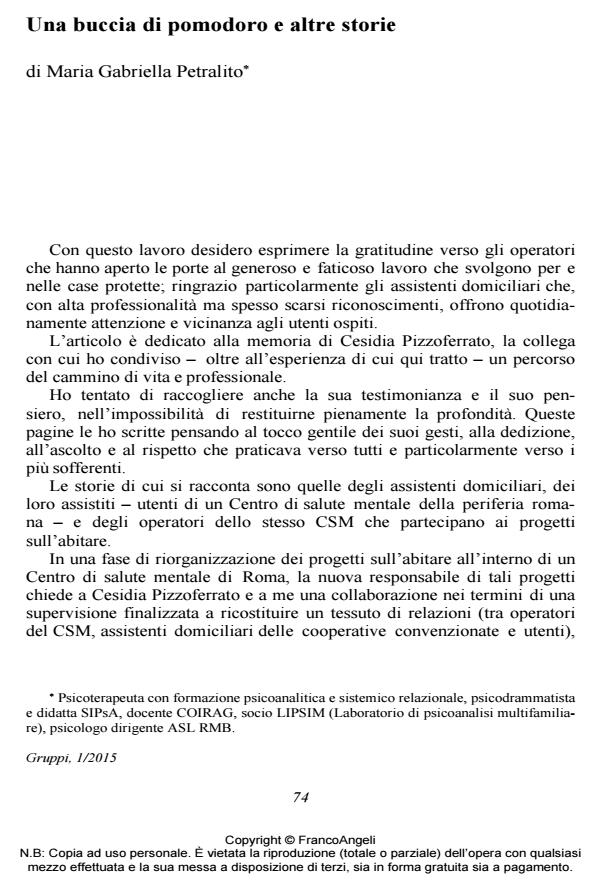Tomato peel and other stories
Journal title GRUPPI
Author/s Maria Gabriella Petralito
Publishing Year 2015 Issue 2015/1 Language Italian
Pages 12 P. 74-85 File size 50 KB
DOI 10.3280/GRU2015-001006
DOI is like a bar code for intellectual property: to have more infomation
click here
Below, you can see the article first page
If you want to buy this article in PDF format, you can do it, following the instructions to buy download credits

FrancoAngeli is member of Publishers International Linking Association, Inc (PILA), a not-for-profit association which run the CrossRef service enabling links to and from online scholarly content.
The article describes an experience of supervision in a public health institution. Supervision is required in a phase of reorganization of home care for psychiatric clients housed in apartaments and is aimed at a broad group of mental health workers. Supervision is renamed plurivision to emphasize the aspects of cooperation and exchange; it’s done in group session trough psychoanalitic psychodrama and collage. Plurivision allows mental health workers to express their feelings of inadequacy ,marked by a severe superego. During sessions three areas are explored : group, space and time; they are knotted to each other by a dimension identified as "plus-une" because of its references to the cartel theorized by J. Lacan. Factor "plus-un" crosses the three areas and consists of life and living elements: objects and things. Things, unlike objects, are in relation with Heimlich. Tomato peel (a thing) appears in the scene of a psychodrama session; it’s on the kitchen floor and causes the fall of a worker but also produces a change of perpective; so emotions and representations become less persecutory for the entire group of mental health workers.
Keywords: Plurivision, psychodrama, collage, objects/things, plus-un factor, Heimlich
- Bodei R. (2009). La vita delle cose. Roma: Laterza.
- Centro Studi Apeiron (2002). Studi sul Cartel. Città di Castello: Edimond.
- Cohen M. (2014). La scena interiore. Milano: Ponte alle Grazie.
- Connor S. (2014). Effetti personali. Vite curiose di oggetti quotidiani. Milano: Raffaello Cortina.
- Eiguer A. (2007). L’inconscio della casa. Roma: Borla.
- Esposito R. (2014). Le persone e le cose. Torino: Einaudi.
- Freud S. (1919). Il perturbante. OSF, 9.
- Montani L. (2012). L’accessorio: una pratica significante. In: Giorgelli C., a cura di, Abito e identità. Ricerche di storia letteraria e culturale. Vol. IV. Palermo: Ila Palma.
- Petralito M.G. (2013). Cominciare dalla fine. Quaderni di Psicoanalisi e Psicodramma Analitico, 5, 1 e 2, consultabile sul sito: www.sipsarivista.it/quaderni/n6_Quaderni_psicoanalisi_psicodramma_analitico_2013.pdf
- Searles H. F. (2004). L’ambiente non umano. Torino: Einaudi.
- Winnicott D. (1974). Gioco e realtà. Roma: Armando Bianchi M., Mauron V. (2010). L’esprit du collage. Lugano: Pagine d’Arte.
- De Marco G. (2007). Gruppi a mediazione terapeutica nella pratica istituzionale. Gruppi, IX, 2: 27-41.
- Vacheret C. (2005). Praticare le mediazioni in gruppi terapeutici. Roma: Borla.
Maria Gabriella Petralito, Una buccia di pomodoro e altre storie in "GRUPPI" 1/2015, pp 74-85, DOI: 10.3280/GRU2015-001006